History
Prior to the final meeting of the merger Weber Lodge № 6 F. & A. M. of Utah, and George Washington Lodge № 24 F. & A. M. of Utah, unanimously agreed by secret ballot to fully adopt and consolidate the history, culture, customs, spirit, members, officers, Pillars, and traditions of all Lodges involved in this merger. In truth, both great Lodges still exist and fully operate inside as; and under the name of Golden Spike Lodge № 6.
Not one moment of its rich history was lost nor forsaken.
In our shared history, Golden Spike Lodge № 6 has had several halls in its lifetime.
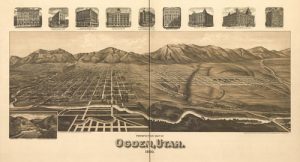
They are:
• First: In a two-story building at 2428 Washington Avenue, from which it and the saloon which occupied the first floor, were moved a short time ‘ later when the Wells-Fargo Bank took over the building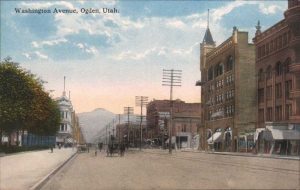
• Second: On the second floor of the Warren G. Child building at 2411 Washington Avenue
• Third: On the third floor of the Drive Building, which occupied the spot where the Warren G. Child’s main office building was located until its recent move to its present location at 25th and Washington Blvd. It was here some nine years and this was the site of the controversial staircase.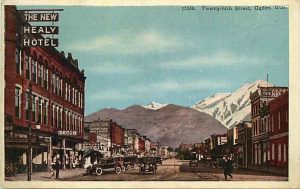
• Fourth: On the third floor of the Dooly Block, which is the building immediately south of the First Security Bank Building.
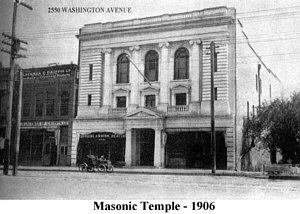
• Fifth: The Temple at 2550 Washington Boulevard
Sixth: The present Ogden Masonic Temple which is located in the big stone white building on the Northeast corner of 20th Street and Harrison Boulevard, in the heart of beautifully scenic Ogden.
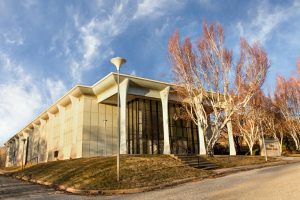 The plans for the new Temple were drawn up by architect Brother Richard Lowe, a member of this Lodge. The plans were approved for the New Temple on March 29, 1966.
The plans for the new Temple were drawn up by architect Brother Richard Lowe, a member of this Lodge. The plans were approved for the New Temple on March 29, 1966.
“Architect of the Building,” Brother Richard D. Lowe, invited the Grand Lodge Officers to conduct the ceremony. Most Worshipful Brother Howard E. Dorst, the Grand Master of Masons in Utah, presided over the ceremonies of laying the cornerstone of October 23, 1966.
Grand Lodge opened on the Entered Apprentice Degree at 2:11 p.m. The procession then proceeded to the site, the northeast corner of the building under construction, where the cornerstone was laid with ceremony at 2:30p.m.
The officers who gave us our humble beginnings were an eclectic group of men, who pioneered the wild west in boom towns like Ogden.
Despite its roots with local church communities, Ogden was once a lawless frontier town teeming with larger-than-life legends and colorful characters. Discover the history of this Crossroads of the West:
From about 400 – 1350 A.D. the area was home to the Great Salt Lake Fremont Indians, followed by the Northern Shoshone and Goshute tribes.
The first permanent settlement by people of European descent in Utah was made here and originally named Fort Buenaventura.It was established by the trapper Miles Goodyear in 1846 about a mile west of where downtown Ogden is currently located.
The settlement was then called Brownsville, after Captain James Brown, but was later named Ogden for a brigade leader of the Hudson’s Bay Company, Peter Skene Ogden, who had trapped in the Weber Valley a generation earlier. There is some confusion in which “Ogden” was the first to set foot in the Utah city. Peter’s older brother Samuel Ogden traveled though the western United States on an exploration trip in 1818. The site of the original Fort Buenaventura is now a Weber County park.
Mormon settlers bought the fort for $1,950 in 1847 and Ogden was incorporated as a city in 1851, making it the third incorporated city west of the Missouri River – after San Francisco and Salt Lake City.
It became a typical western community of homes and businesses centrally located with farms surrounding the outlying areas. The Ogden River to the north and the Weber River to the west created a natural boundary to separate farm land from land for development.
January 23, 1855 John M. Browning was born in Ogden. He later developed numerous firearms and invented technology that changed the industry.
Ogden is the closest sizable city to the Golden Spike location at Promontory Summit, Utah, where the First Transcontinental Railroad was joined in 1869.
With the completion of the transcontinental railroad, Ogden welcomed the world via the Union Station Depot, the junction for railroad travel in the Intermountain West for several decades.
On March 8, 1869, the first locomotive steamed into Ogden following right behind the Union Pacific track layers. The citizens of Ogden came out to welcome the train with banners that read, “Hail to the Highway of the Nations! Utah bids you Welcome.”
Ogden was known as a major passenger railroad junction owing to its location along major east–west and north–south routes, prompting the local chamber of commerce to adopt the motto, “You can’t get anywhere without coming to Ogden.”
Tullidge’s Quarterly magazine reported, “Three cheers for the great highway were then proposed and given, when the wildest enthusiasm and demonstrations of joy prevailed, and the shouts rent the air. Amid the alternate pealings of the artillery’s thunder, the music of the band, and the long continued shrill whistling of the three engines, the waving of hats, kerchiefs, and other demonstrations of pleasure, rendered the occasion such as will not soon be forgotten by those present.”
With the connection of the Union Pacific and the Central Pacific, along with other rail lines that went north and south of Ogden in the following years, Ogden was designated in 1874 as the junction location of the two companies, earning it the nickname “Junction City.”
November 12th, 1874 WEBER LODGE № 6 F. & A. M. of Utah was chartered, and constituted. Weber Lodge served as the primary Lodge for freemasons of Weber, Davis, and Morgan County for the next several decades.
All sorts of visitors – some legitimate and some not so much – poured into town, strolling up and down Historic 25th Street to prospect for business, dine, gossip, and enjoy upscale shopping.The city quickly became known for its rough and tumble character, a place where one could witness people committing the worst vices in open view.
An article in the Western Galaxy dated June of 1888 stated, “Indeed, the ‘Junction City’ has a future almost certain to put in the shade any of her sister cities; she is likely to become the Chicago en miniature of the Intermountain region.”
May 8, 1905 Ernest Loring “Red” Nichols was born in Ogden, Utah. Red became musical pioneer, jazz cornetist, composer, and jazz bandleader.
February 17th, 1912 UNITY LODGE № 18 F. & A. M. of Utah was chartered, and constituted. Ogden welcomed its second Lodge.
In the 1920’s – Brooklyn born, Alphonse Gabriel Capone, himself was a local patron of the notorious “Two-bit” Street. Known as being a nefarious character of ill-repute, Even Capone was heard to comment that Ogden ‘was too wild a town even for [him]’.
January 22nd, 1921 GEORGE WASHINGTON LODGE № 24 F. & A. M. of Utah was constituted. Ogden welcomed its Third Lodge.
In 1954, the city effected a clean up of both the streets and the local government. Lorin Farr was mayor of Ogden at the time. He advised his police force in the following way: “Use kindness, be ready for emergencies, and see that guns and pistols are always loaded and powder dry.”
Such tough love cleaned up the streets of Ogden.
Byron Anton Scott was born March 28, 1961 in Ogden Utah. He later became a professional basketball player and former head coach. He last coached the Los Angeles Lakers. As a basketball player he earned three championships.
On March 29, 1966, Grand Lodge approved the plans for the New Ogden Masonic Temple.
October 23, 1966, Grand Lodge opened on the Entered Apprentice Degree at 2:11 p.m. The procession then proceeded to the site, the northeast corner of the building under construction, where the cornerstone was laid with ceremony at 2:30p.m. Most Worshipful Brother Howard E. Dorst, the Grand Master of Masons in Utah, presided.
December 18th, 2004 GOLDEN SPIKE LODGE № 6 F. & A. M. of Utah successfully merged. Golden Spike Lodge № 6 fully assimilated Weber and George Washington Lodge, infused with the spirit of those courageous pioneers who brave untold futures in new frontiers. On this day, Golden Spike Lodge № 6 was reborn and constituted as Ogden‘s hardest working and most diverse Lodge.
Today Ogden is a beautiful, friendly city. It is a wonderful place to visit.
The city has several fine attractions. Union Station on 25th Street is a wonderful stop for Ogden visitors. The original structure of the Union Station Depot burned in 1923. Today, however, the rebuilt Union Station houses several fine museums. Whether influenced by our many great community leaders or the growth of the human spirit; Ogden has become one of the greatest communities in the World; and Home to several Masonic Lodges.
OFFICERS OF WEBER LODGE № 6 F. & A. M. of Utah.
U.D. November 27th, 1873
Worshipful Master: C. S. Nellis
Senior Warden: Alvin D. Shakespeare
Junior Warden: Henry Bruce
Treasurer: John S. Lewis
Secretary – Chaplain: L. W. B. Long
Senior Deacon: H. M. Cameron
Junior Deacon: James Forbes
Tyler: Edward H. Reed
OFFICER OF WEBER LODGE № 6 F. & A. M. of Utah.
-Petitioned January 8th, 1874
-Chartered November 12th, 1874
-Constituted November 12th, 1874
Worshipful Master: Alvin D. Shakespeare
Senior Warden: James Forbes
Junior Warden: Stephen S. Schramm
Treasurer: John S. Lewis
Secretary: Walter S. Holbrook
Senior Deacon: Edward H. Reed
Junior Deacon: Joseph J. Clayton
Senior Steward: Samuel P. Warden
Junior Steward: Michael Buchmiller
Tyler: George W. Murphy
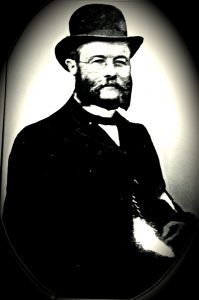 Note: Alvin D. Shakespeare, our first Worshipful Master, was a saloonkeeper in Ogden Utah (Formerly a railroad Boomtown known as Junction City).
Note: Alvin D. Shakespeare, our first Worshipful Master, was a saloonkeeper in Ogden Utah (Formerly a railroad Boomtown known as Junction City).
OFFICERS OF GEORGE WASHINGTON LODGE № 24 F. & A. M. OF UTAH .U.D.
May 28th, 1920
Worshipful Master: Franklin Cook Osgood
Senior Warden: James Walter Ellingson
Junior Warden: William Jackson Allison
Treasurer: Frank Henry Smith
Secretary: Winfred Burton Mowfray
Chaplain: Vacant
Senior Deacon: Clarence Ferdinand Koratian
Junior Deacon: Warner Arthur
Senior Deacon: Willard Giles Wilson
Junior Deacon: James Albert Shepherd
Organist: Vacant
Tyler: George St. Bartlett
OFFICER OF GEORGE WASHINGTON LODGE № 24 F. & A. M. OF UTAH,
-Petitioned December 13th,1920
-Chartered January 19th, 1921
-Constituted January 22nd, 1921
Worshipful Master: Franklin Cook Osgood
Senior Warden: James Walter Ellingson
Junior Warden: William Jackson Allison
Treasurer: Frank Henry Smith
Secretary: Winfred Burton Mowfray
Chaplain: Vacant
Senior Deacon: Clarence Ferdinand Koratian
Junior Deacon: Warner Arthur
Senior Deacon: Willard Giles Wilson
Junior Deacon: James Albert Shepherd
Organist: Vacant
Tyler: George St. Bartlett

